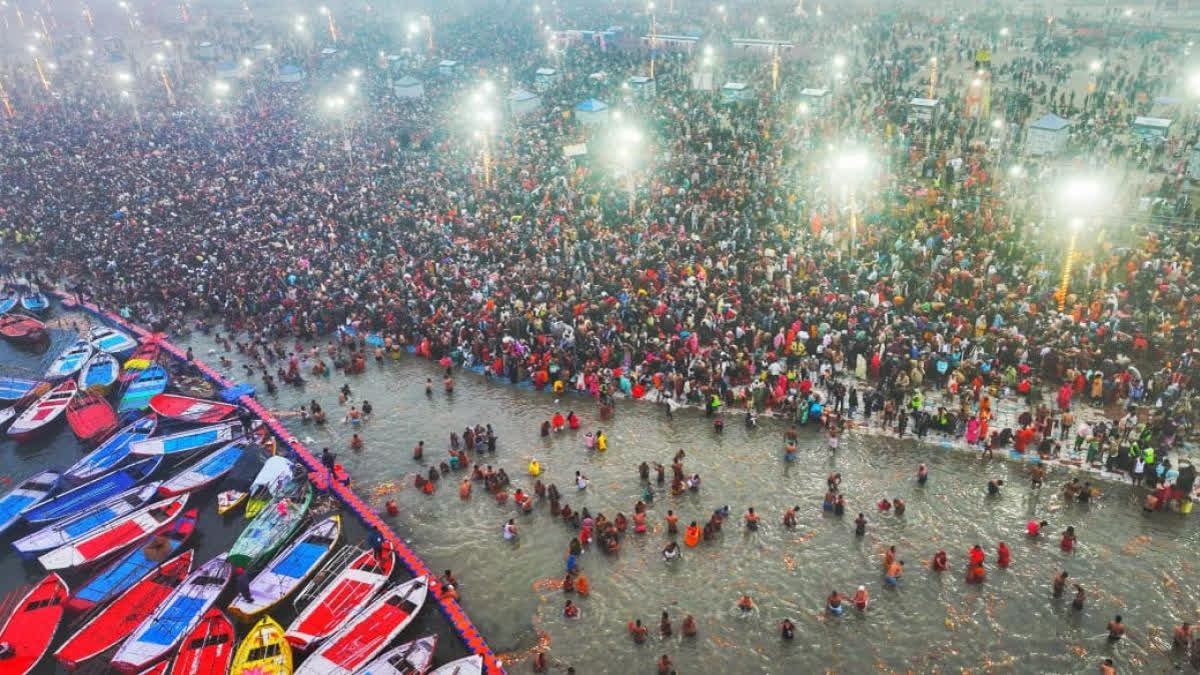Prayagraj: With the commencement of the Mahakumbh Mela here on Monday that will last till February 26, scholars from the US and Europe will gather here later this month to study the essence of this event that holds immense religious significance for Hindus across the world.
Till now, 12 scholars, mostly from the US and Europe, confirmed that they will participate in a three-day meeting from January 25 to 27 to study the history and essence of the Mahakumbh. They are all members of the Society of Pilgrimage Studies.
“The Society of Pilgrimage Studies is a society of scholars who work in the field of pilgrimage traditions and sacred places of all religions," BP Dubey, general secretary of the Society told ETV Bharat here. "Generally scholars from the US, Canada, Europe, and sometimes from China become members of this Society."
At the same time, Dubey also stated that scholars from Southeast Asia are not interested in the field of sacred places although there are many temples in that region. "Most of the scholars in the Society are interested in the study of Sanatan Dharma,” he said. “We have different aspects of the study of sacred places.”
Dubey, a retired professor of the Department of Ancient History, Culture and Archaeology in Allahabad University, explained that, in India, tradition is very strong but most of these are not supported by shastricevidence.
Shastra is a Sanskrit word that means "precept, rules, manual, compendium, book of treatise" in a general sense. There are six shastras known as Vedangas. These auxiliary texts explain the proper interpretation and application of the Vedas, the sacred scriptures of Hinduism.
File photo of BP Dubey, general secretary of the Society of Pilgrimage Studies (ETV Bharat) Dubey explained that, in India, there are two traditions – folk tradition and shastric tradition. "For example, let's take the Mahakumbh Mela," he said. "There are very few shastric evidences of this and it is based on the folk tradition. Some shastric evidences have been found but these were found here and there. We have to read all the evidence at one place."
Dubey then went on to explain that Prayagraj was regarded as the “king” of all Hindu sacred places. All sacred places of Hinduism had embassies in Prayagraj. "That is because Prayagraj is regarded as a sacred place in the Rig Veda," he said. "No other Hindu sacred place is mentioned in the Rig Veda except Prayagraj."
Dubey elaborated that there are two sacred rituals according to the Rig Veda. The first is that those who take a bath in the confluence of the Ganga and the Yamuna – or Sangam where the Mahakumbh Mela is taking place – attain heaven after death. The second ritual is that those who die by religious suicide attain immortality.
The second ritual continued till 1840 after which the British banned the practice. However, according to Dubey, there is still the belief that elederly people who die when they come on a pilgrimage to the Mahakumbh Mela attain immortality.
"Only three sites figure as sacred in Hinduism in Vedic literature," Dubey said. "One is the Sangam in the Nadistuti Sukta of the Rig Veda. The second is the Sannihiti Sarovar at Kurukshetra in the Shatapath Brahmana. And the third is the Vishnupada at Gaya in Nirukta of Yaska."
However, he said that "we get 1,000 more sacred places/sites from the Mahabharata and the number increases in the Puranas". Dubey further explained that Prayagraj is the first place considered to be holy. In fact, Prayagraj is the oldest sacred place of any religion in the world. He further explained that Prayag is a prefix meaning “most superior” and is associated with cultivation through ploughing.
“Within a 200-km radius of Prayagraj, we find very high-quality rice grain,” Dubey said. “The earliest cultivation of rice was in Prayagraj. Fine-grained rice was discovered by the archaeologists of Allahabad University in 1977-78 dating back to 8-7th millennium BCE. In 2003, fine-grained rice was found dating back 7-6th millennium to from Jhusi mound near Sangam and Hetapatti, five km north on the left bank of the Ganga. So, rice evidence comes from sites near the Ganga-Yamuna Sangam."
He also pointed out that, in the Rig Veda, there is a "sukt" or chapter devoted only to praying to the river. "In Prayagraj, only water is worshipped," Dubey said. "In a way, it is worshipping nature. That is why this Mela is linked to water. Both Haridwar and Prayag (where Kumbh Melas are held) are on the banks of the Ganga."
"The scholars from the Society of Pilgrimage Studies who will be coming later this month for the three-day meet will discuss all these and more," he said. "They want to find out why people come to take a bath in the Sangam in such harsh winter."
Dubey then explained that many of the scholars in the Society of Pilgrimage Studies work in India with their own resources. They like staying in the Society’s camps as pilgrims.
